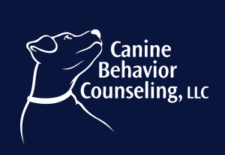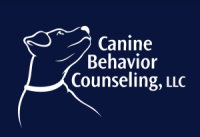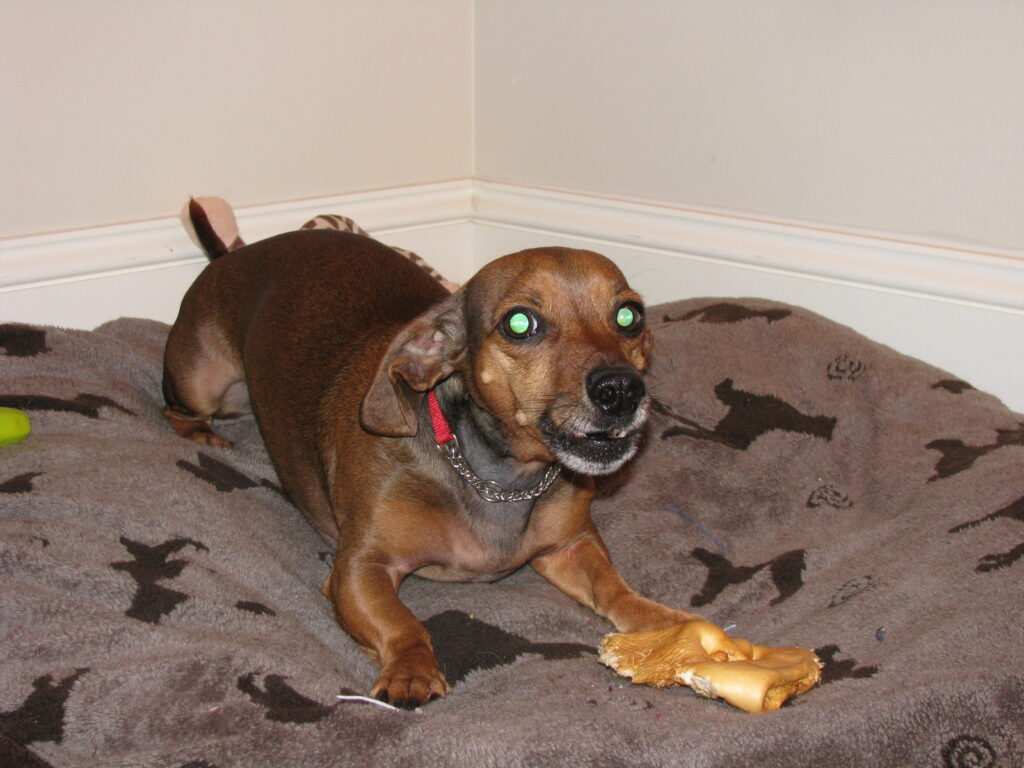Playing Games with your dog can improve your relationship and reduce Resource Guarding.
The Emotional dog
The emotional, less social dog will likely grab and item and move across the room with a more purposeful feeling as he seeks a place AWAY FROM YOU to go under or behind to retain possession of his item. His stride may appear to be stiff and quick rather than bouncy and fluid. He will likely keep the item in his mouth at rest.
When you approach you will likely notice this dog’s body is stiff as adrenalin begins to pump through his veins, preparing for a fight. This dog is often void of any movement. He will likely be holding the item “deep” in the back of clenched jaws or he may cover it with his lower jaw. His pupils may look large as you notice he is not blinking, but staring at you.
This dog is not interested in cooperating and may be quick to lift his lip, show his teeth or growl to defend his prize. This is what resource guarding looks like, and, sadly, is practiced by the emotional, less social dog.
Resource Guarding can start at an early age. If you suspect your puppy is showing signs of guarding behavior, play the following games to facilitate a trusting cooperative relationship.
Free Choice
With your dog on a leash in a neutral setting such as your yard, garage, deck or park setting. Lay out several items of interest to your dog. They may include but are not limited to, your shoe, boxes, dog bowl, plate, snuffle mat, hat, glove, towel, basket anything your dog might want to smell. Practice walking with your dog up to the object of his choosing.
Then move on to the next item of your dog’s choice. Again, this is a cooperative sniffer game that you do with your dog. There is no food on any of the items at this point. You can and should speak to your dog and pet them as they walk about this area.
Add Value
Practice walking with your dog up to the objects again. Let your dog smell the box, towel, bowl, plate, snuffle mat. Your dog may decide to look at you or he may think about moving away to smell a tree. Now, add treats to the item. You can say “find it” as a cue to hunt for food. Then move on to the next item of your dog’s choice. Again, this is a cooperative game that you do with your dog. Remember to breathe, speak to your dog and if you are comfortable, pet your dog while playing this game in a neutral location.
Physical Contact
Same Set up as above. As you approach the empty item, wait for your dog to look at you. Say “yes” or click and then pick up the item and add food to it. Place it back on the ground and let your dog enjoy at his own pace. This is a cooperative approach, so speak kindly to your dog and watch their body soften and wiggle with pride. Move to the next item together, wait for eye contact, pick up the item and add food for your dog to enjoy.
This game gives the control to the dog and reduces his stress. He is learning that when he looks at you, good things happen. He is also learning that when you are near, he does not need to guard to earn a reward anymore. He is rewarded by cooperating with his human.
Adding Tug, with Rules
Playing the game of Tug can be an effective way to teach your dog a “drop” behavior. Begin my dragging your dog’s toy on the ground. When he bites it say “yes, tug”. Keep the item low to the ground and keep the intensity low also. Tug for at least a minute while speaking to your dog and petting him. Reward with a treat to your dog’s nose when you ask for a “drop” and he let’s go.
Do not continue to pull on the toy when you ask for a “drop”. Be sure to lighten your grip or let him win to help him understand the game is ending. Also, do not reach for the toy right away. Ask him to “get it” or “fetch” and see if he will bring you the toy for play. Try showing your dog the toy and ask for a “sit”, say “yes” and offer the toy as a reward when he complies. Again, keep the intensity low. It is fine to let him win and then ask for a “drop” and reward. Now just let him get the toy.
Be Fair! When you are done playing, say “done” as you put the toy away. Avoid asking for a “drop” and putting the toy in the cabinet. This is not fair, and your dog may not comply next time.
Counter Condition how your dog “feels” when you approach.
Approach and Feed – no resource
Approach your dog at a relaxed pace and at an angle while saying the dog’s name in a happy tone. Give the dog a few yummy treats on the floor or his mat and walk away. If you are worried or your dog becomes still simply toss the treats to the dog. If he growls, toss the treats anyway! Repeat this many times per day in different environments and you will quickly see your dog change his mind about your approach.
After you are comfortable with the above, progress to hand feeding the dog. Again, approach in a relaxed pace at an angle while saying the dog’s name. Put your hand out and say “take it” as you had feed the dog and walk away. Repeat this many times when the dog does not have a resource. You can use his meals to approach many times and add food to his bowl.
Approach and feed – low value resource.
Next, practice the above two steps while the dog has a low value resource. This can be a low value toy, an empty kong, or any other toy he will not guard. Be sure the treats you are feeding are valuable to your dog.
Adding a verbal cue – no resource
Approach the dog at a relaxed pace at an angle while saying the dog’s name and the cue “drop or give” in a happy tone. Toss a treat between his front paws. Say the word 5 or 6 times and continue to drop treats each time. The goal is for your dog to hear the word and anticipate something yummy! The higher the value the stronger the association will be.
Approach, say cue and feed
Next, give the dog a resource, that he is unlikely to guard. This may be an empty kong, an old box, soup can, empty bowl or old toy. Approach the dog and say his name in a happy tone and then say the cue word in a happy tone also, “give or drop”. Toss or hand feed a few yummy treats on the floor or his mat and walk away. Repeat several times in different locations. Do not take or even touch the resource. Repeat the exercise several times with different objects of value on the ground.
Repetition is essential to change a dog’s habit
Practice several repetitions a day, varying the resource, and location in your home. Many dogs are aware of space around them and will be more guarded if in a smaller space. Continue to use low value items in the first few weeks. When you have a history of successful approaches, with your dog smiling up at you, you can increase the value of the item as you approach. Remember the higher value item the dog has the higher value your treat must be.
Exchanges exercises – low value item
You are now ready to exchange the item for a handful of treats and then give the resource back to your dog. Give the dog a resource that he is unlikely to guard. Approach the dog and say his name and the cue word. “Give or drop”. When he spits the toy out verbally praise him “good boy!” and hand feed a few yummy treats as you pick up the toy and hold it near him. When he is done eating the treats offer him the toy back and walk away. Repeat several times in different locations with different objects. If he grabs the item from you harshly, avoid picking it up for a while, as he is untrusting.
Exchange exercises – low to medium value item
Remember to say your dog’s name and cue word “drop/give” in a positive happy tone as you approach. The goal is for your dog to easily relinquish his prize because he associates your approach with yummy food! Sometimes you can pick up the item and feed your dog, other times you can ignore the item all together.
For dogs who have bitten, slow down your progression and re-evaluate your parenting style. Prove to your dog that when you approach, it “feels” good to your dog. Avoid using physical punishment on your dog as he may not bite you, but will still bite others. Dominance is NOT a long terms solution. Cooperative training is proven to work with hundreds of dogs.
Above all else, avoid pushing your dog to the point of biting you and remember Resource Guarders are socially insecure and are trying to bully their humans because they are already afraid of humans. Avoid harsh corrections as this dog will likely get much worse.


